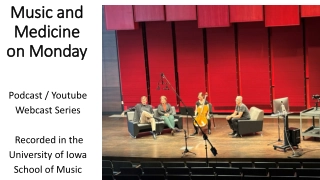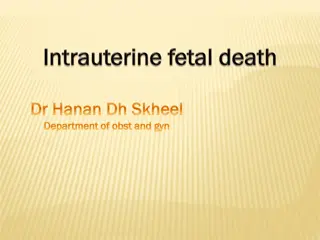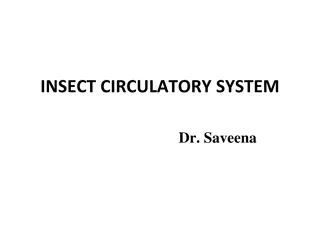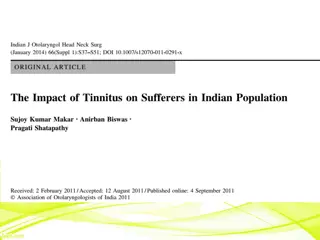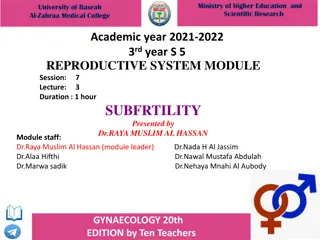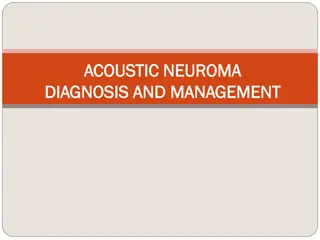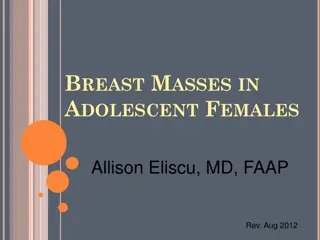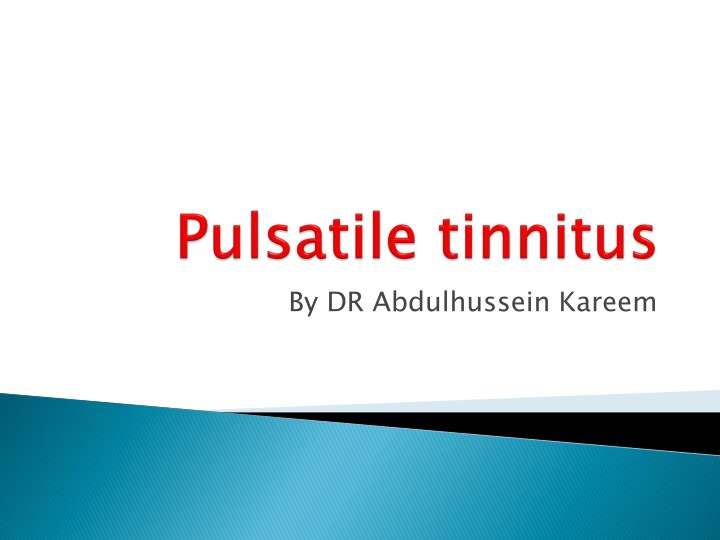
Pulsatile Tinnitus: Causes, Diagnosis & Management
Pulsatile tinnitus is a unique auditory condition characterized by a rhythmic noise often synchronized with the pulse. This article explores the various causes of pulsatile tinnitus, differentiating between arterial and venous origins, and discusses the diagnostic approach including history, examination, and imaging techniques. It emphasizes the importance of proper evaluation to determine the underlying etiology for appropriate management.
Download Presentation

Please find below an Image/Link to download the presentation.
The content on the website is provided AS IS for your information and personal use only. It may not be sold, licensed, or shared on other websites without obtaining consent from the author. If you encounter any issues during the download, it is possible that the publisher has removed the file from their server.
You are allowed to download the files provided on this website for personal or commercial use, subject to the condition that they are used lawfully. All files are the property of their respective owners.
The content on the website is provided AS IS for your information and personal use only. It may not be sold, licensed, or shared on other websites without obtaining consent from the author.
E N D
Presentation Transcript
Pulsatile tinnitus is often described as a heartbeat or whooshing noise, it is infrequent with 10% prevalence. 86% is subjective pulsatile tinnitus and 14% is objective. Pulsatile tinnitus is mostly secondary as compared with nonpulsatile type. Mostly due to vascular etiologies.
The tinnitus may be synchronized with pulse or not. Causes; Synchronous with pulse; Arterial causes; 1. cardiovascular like HT and valvular heart disease. 2. intraosseous like Paget disease and otosclerosis.
3.Neoplasms like paraganglioma(glomus tympanicum or jugulare) and vest schwannoma. 4.Vascular stenosis like carotid artery atherosclerosis. 5.Skull base anomalies like persistent stapedial artery and intratympanic carotid artery. 6.Hyperdynamic circulation with increased cardiac output like thyrotoxicosis, anemia, and pregnancy.
Venous causes; 1.Sigmoid sinus and jugular bulb anomalies. 2.Idiopathic intracranial hypertension. 3.Dural sinus stenosis (transverse or sigmoid sinus). 4.Ideopathic tinnitus (venous hum).
Asynchronous with pulse; 1. Muscular myoclonus palatal, tensor tympani or stapedial. 2.Otologic ; Patulous Eustachian tube. Ossicular or tympanic mem abnormalities. Otosclerosis. Semicircular canal dehiscence. OME. 3.TMJ diseases.
Diagnostic approach; History and physical examination done to detect the underlying causes . Hearing assessment. Imaging like CTA\V,MRA\V and angiography. The investigations done for the pt can discover the underlying etiology in 30% to 70%. History and examination findings should direct the imaging type e.g. pulsatile tinnitus and autophony raise suspicion for semicircular canal dehiscence or patulous ET
And supports the need for nasal endoscopy and high resolution CT scan. Carotid doppler ultrasonography is considered in suspected atherosclerosis. When tinnitus is accompanied with obesity ,idiopathic intracranial hypertension is considered and MRI is required.
Vascular anomalies; Providing normal ear examination, intracranial venous abnormalities are the most common cause of pulsatile tinnitus while cervical atherosclerosis is the most frequent cause of arterial pulsatile tinnitus. Anomalies of the jugular bulb; The jugular bulb represents the junction between distal sigmoid sinus and proximal IJV
Jugular bulb anomalies can manifest as venous pulsatile tinnitus accounting for 15% to 30% of secondary pulsatile tinnitus. In some cases ,otoscopy reveals a blue mass in the floor of the middle ear that increases with Valsalva maneuver and decreases with compression of IJV. High riding jugular bulb when it extends above the annulus or lies within 2 mm of the internal auditory canal floor.
Jugular bulb diverticulum is outpouching of the vessel wall into the mastoid ,middle ear or the petrous apex. In suspected anomalies, high resolution CT scan of temporal bone with contrast is recommended. Treatment ; Observation,. Endovascular or surgical intervention.
Sigmoid sinus diverticulum; It accounts for 20% of cases of pulsatile tinnitus. Turbulent blood flow within the sigmoid sinus may erode the mastoid bone leading to diverticulum. CTA\V is recommended . Treatment by reconstruction of the sigmoid sinus wall with temporalis muscle and fascia or bone wax.
Dural arteriovenous malformation\fistula. These are aberrant vascular connections between dural arteries and venous sinuses. Accounting for 10% to 15% of all cerebrovascular malformations. They may be congenital or acquired and the location and size determine the clinical features which include pulsatile tinnitus, headache and focal neurologic abnormalities
Treatment ; Endovascular embolization. Surgery. Gamma knife radiosurgery. Atherosclerotic carotid art disease; Atherosclerosis causes turbulent blood flow which may be felt as pulsatile tinnitus , it is the most common cause of arterial pulsatile tinnitus.
Atherosclerosis accounts for 12% of all cases of pulsatile tinnitus. Should be considered in hypertensive, diabetic pt or smoker and those with hyperlipidemia. Doppler ultrasonography should be done for pt. Treatment ; Catheterization and stenting.
Idiopathic intracranial hypertension; Characterized by increased intracranial pressure without an identifiable cause . Typically present in obese, young women with symptoms of headache ,visual disturbances, occasionally with pulsatile tinnitus, hearing loss and vestibular symptoms. Pulsatile tinnitus may be due to turbulent blood flow or due to cerebral edema that may stretch the 8thcranial nerve.
Diagnosis; 1. Signs and symptoms of increased ICP such as headache or papilledema without focal neurologic deficit. 2.Normal MRI or CT scan. 3.Elevated ICP above 250 mm water on LP without CSF abnormalities.
Treatment; Weight reduction. ICP reduction by corticosteroids, diuretics and acetazolamide. Surgery like bariatric surgery or CSF diversion surgery.
Vascular neoplasms; Paragangliomas; Vascular skull base tumors can present with pulsatile tinnitus. Paragangliomas(glomus tumors) are the most common vascular skull base tumors of the temporal bone. 80% are sporadic and the rest is familial.
Familial type are inherited as autosomal dominant ,present at earlier age with possibility of multifocality . They are slow-growing neuroendocrine tumors that arise from embryonic neural crest cells surrounding the Jacobson nerve (glomus tympanicum) or the jugular bulb(glomus jugulare).
They present as red pulsatile retro tympanic mass on otoscopy, most of them are benign but they can destruct adjacent structures. 1% to 2% are catecholamine secreting tumors. Imaging studies; CT angiography to detect bony destruction of nearby structures. MRI to detect the vascularity .
Treatment; 1.Observation. 2.External beam radiation. 3.Stereotactic radiosurgery. 4.Microsurgical excision. Other vascular skull base neoplasms; Like endolymphatic sac tumors,hemangiopericytoma,meningiomas,an d temporal bone hemangioma.
Nonvascular etiologies; Semicircular canal dehiscence; It may be congenital or acquired or both . It is associated with auditory and vestibular symptoms. Tullio phenomenon vertigo in the presence of loud sound can be seen in perilymph fistula, syphilis, and stapes footplate injury. Henneberts sign pressure induced vertigo ,it may be seen in perilymph fistula or Meniere disease
Diagnosis; History ,pneumatic otoscopy,imaging,and audiometric testing. HOMEWORK High resolution CT scan can be used to detect the dehiscence but may have false positive results. MRI 100% sensitivity . Treatment by cap the dehiscence
Myoclonus; Palatal and middle ear muscular myoclonus can lead to pulsatile tinnitus. In the palate, spasm of the muscles leads to opening and closure of Eustachian tube leading to subjective or objective pulsatile tinnitus that is asynchronous with the pulse.
Treatment; Observation. Masking. Muscle relaxants. Botulinum toxin injections. Eustachian tube occlusion. Stapedial or tensor tympani myoclonus can lead to subjective or objective pulsatile tinnitus that is asynchronous with the pulse.
Otoscopy may show periodic movement of the tympanic memb or may be detected by tympanometry how?????? Treatment; Observation. Masking. Placing pledget with botulinum toxin into the middle ear .
Patulous Eustachian tube; In 6% of population ,it is predominantly in open position leading to constant communication between the nasopharynx and middle ear. The pt present with aural fullness or pressure,autophony,audible breathing, and pulsatile tinnitus. Symptoms are exacerbated by exercise and improve when supine.
Causes; 1. Idiopathic. 2.Significant weight loss. 3.Diuretics in congestive heart failure. 4.Pregnancy. 5.Nasal decongestants or steroid sprays. 6.Nasopharyngeal radiation.
Diagnosis ; By endoscope for ear and nose. Treatment; Discontinuation of nasal sprays. Nasal estrogen drops. Weight gain. Augmentation of the Eustachian tube orifice with bulking agent.
Other nonvascular etiologies. 1.Osseous dysplasia of the temporal bone like otosclerosis and Paget disease. 2.Middle ear effusions. 3.TM perforations. 4.Ossicular abnormalities.

